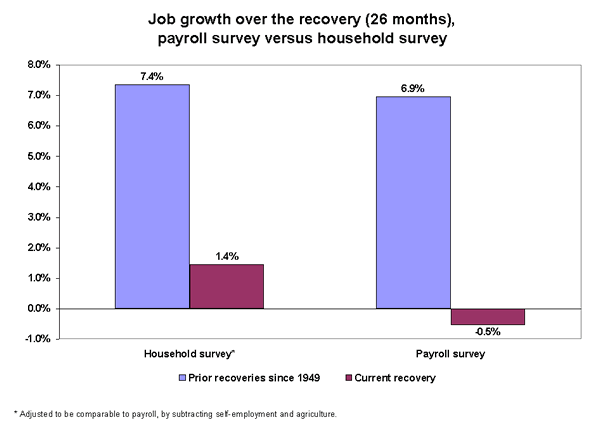February 6, 2004
Payrolls up, but growth not sufficient to boost wages
The nation’s payrolls expanded by 112,000 in January, the best month for job gains since payrolls reversed their long slide last September, according to today’s report from the Bureau of Labor Statistics. Unemployment fell slightly, to 5.6%, the lowest jobless rate since January 2002. Wage growth remains subdued, and weekly earnings—at 1.7% over the past year—are falling in inflation-adjusted terms.
Despite recent growth in payrolls, revised numbers released today reveal that the job losses over the recession and ensuing jobless recovery have left us with a significant job deficit. Payrolls remain 2.4 million down from when the recession began in March 2001 and 716,000 lower than when the recovery officially began in November of that year. In every other recovery on record, the recessionary losses had already been recouped by this point in time.
One reason for this remaining jobs problem is the historically slow pace of job growth since payrolls began expanding last September. Since then, the average monthly job gain has been 73,000, compared to 216,000 per month in the comparable point in the previous recovery.
Most of the net job gains last month—76,000—came from the retail trade sector. However, since retailers hired fewer temporary workers over the holiday season, there were fewer layoffs than usual this January. But the BLS bases its assumptions on historical patterns, which likely overestimate retail job growth. Extracting from this seasonal effect, retail employment is up only 9,000 since October.
Additionally, the return of striking workers added 9,000 jobs in warehousing and storage. Thus, outside of retailing, genuine employment gains amounted to 27,000 last month.
The household survey showed very large employment growth last month (496,000), and has consistently outpaced the payroll survey over the recovery, leading some analysts to discount the jobless recovery. However, in a detailed statement released with today’s report, the BLS commissioner once again stressed the Bureau’s position that the payroll survey offers a more accurate picture of job growth than the household survey. (For further comparison of the payroll and household surveys, see the EPI Briefing Paper Measuring Employment Since the Recovery). Importantly, as the figure below reveals, both surveys show this recovery to be particularly weak in terms of job growth; in fact, regardless of survey choice, this is the worst jobs recovery on record.1

The large growth in household employment last month was met by an equally large expansion of the labor force, suggesting considerable competition for the jobs that are being created. Thus, the number of unemployed fell only slightly, by 74,000.
Two other signs of tough job-market competition are the increase in long-term unemployment and continued weakness in wage growth.
The share of the unemployed who have been seeking work for at least half a year grew to 22.7% in January, compared to 20.3% a year ago and 14% when the recovery began. At this point in the last recovery (May 1993) 19.6% of the unemployed had been without work for six months or more.
The persistence of weak job growth and relatively high unemployment has slowed the growth of earnings (see the EPI Issue Brief Weak Recovery Claims New Victim: Workers’ Wages for a more detailed discussion). On a yearly basis, hourly earnings are growing at 2%, just about the rate of inflation. More recently—and despite faster overall economic growth—hourly wage growth has slowed further, and is up 1.5% at an annual rate over the past three months. Weekly earnings are also falling behind inflation, up 1.7% over the past year.
On the plus side, weekly hours grew by two-tenths of an hour last month. In tandem with employment growth, this increase in weekly hours led to a 0.8% gain in the total hours worked in the private sector, the largest monthly gain since February 1997, and the first hard data suggesting positive overall growth in the first quarter of 2004.
Nevertheless, regardless of which survey is used, the labor market is still characterized by a significant jobs deficit, and this remains the weakest jobs recovery on record. Outside of retail and accounting for returning strikers, net hiring amounted to 27,000, far below the 150,000 benchmark of that is needed to keep up with the growth of the working-age population. The lack of sustained job creation at a level commensurate with this stage of the economic expansion is generating long-term joblessness and stagnant wage growth.
—Jared Bernstein
with research assistance by Yulia Fungard
1. Data were generated by subtracting self-employment and agriculture jobs from the household survey to make the two surveys roughly comparable. Average job growth was then calculated over every prior recovery since 1949 (that lasted at least 26 months), and compared to the growth rate of the current recovery.
For more information on January job and wage data, go to EPI’s new web feature JobWatch.org.
To view archived editions of JOBS PICTURE, click here.
The Economic Policy Institute JOBS PICTURE is published each month upon release of the Bureau of Labor Statistics’ employment report.
EPI offers same-day analysis of income, price, employment, and other economic data released by U.S. government agencies. For more information, contact EPI at 202-775-8810.
